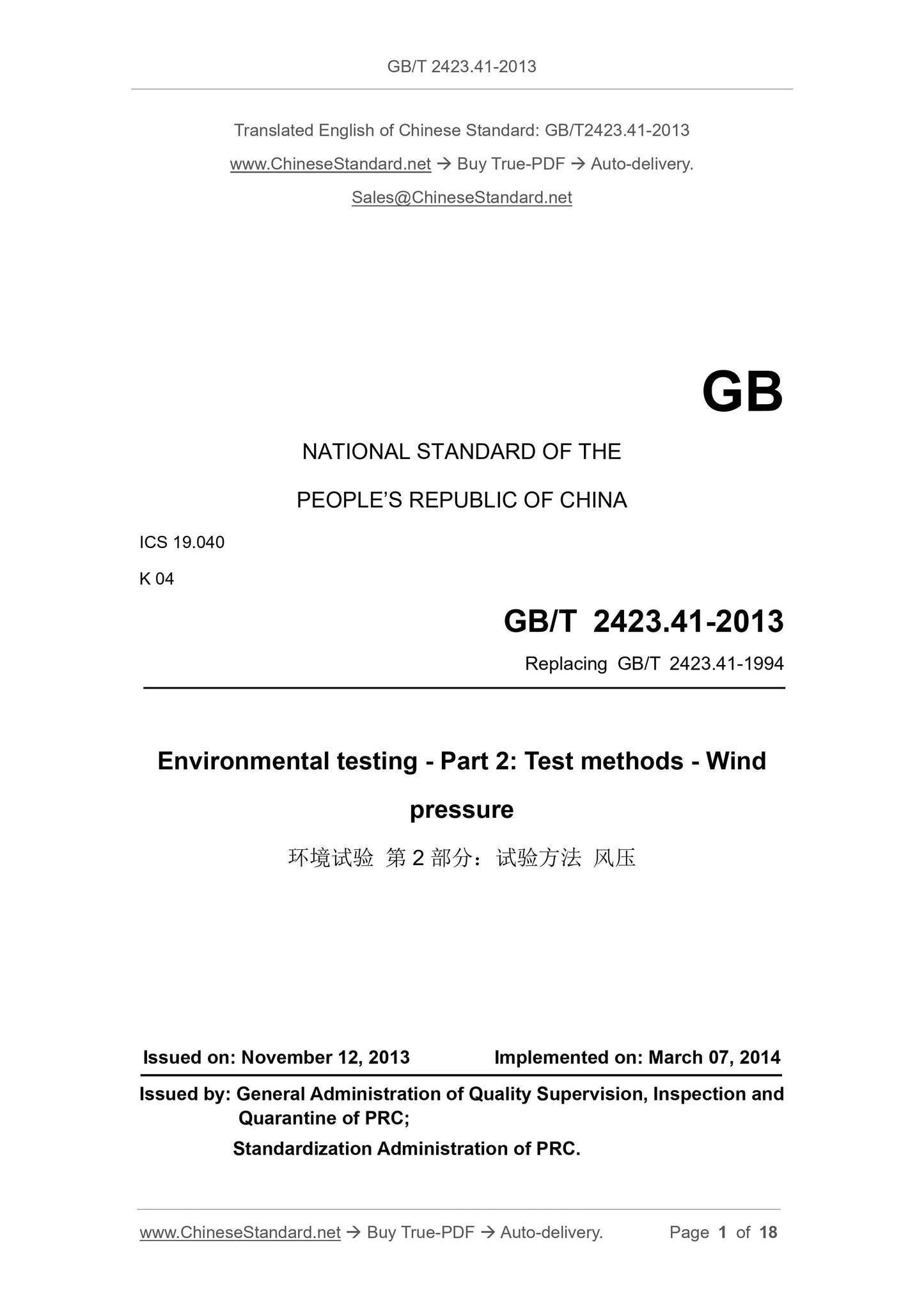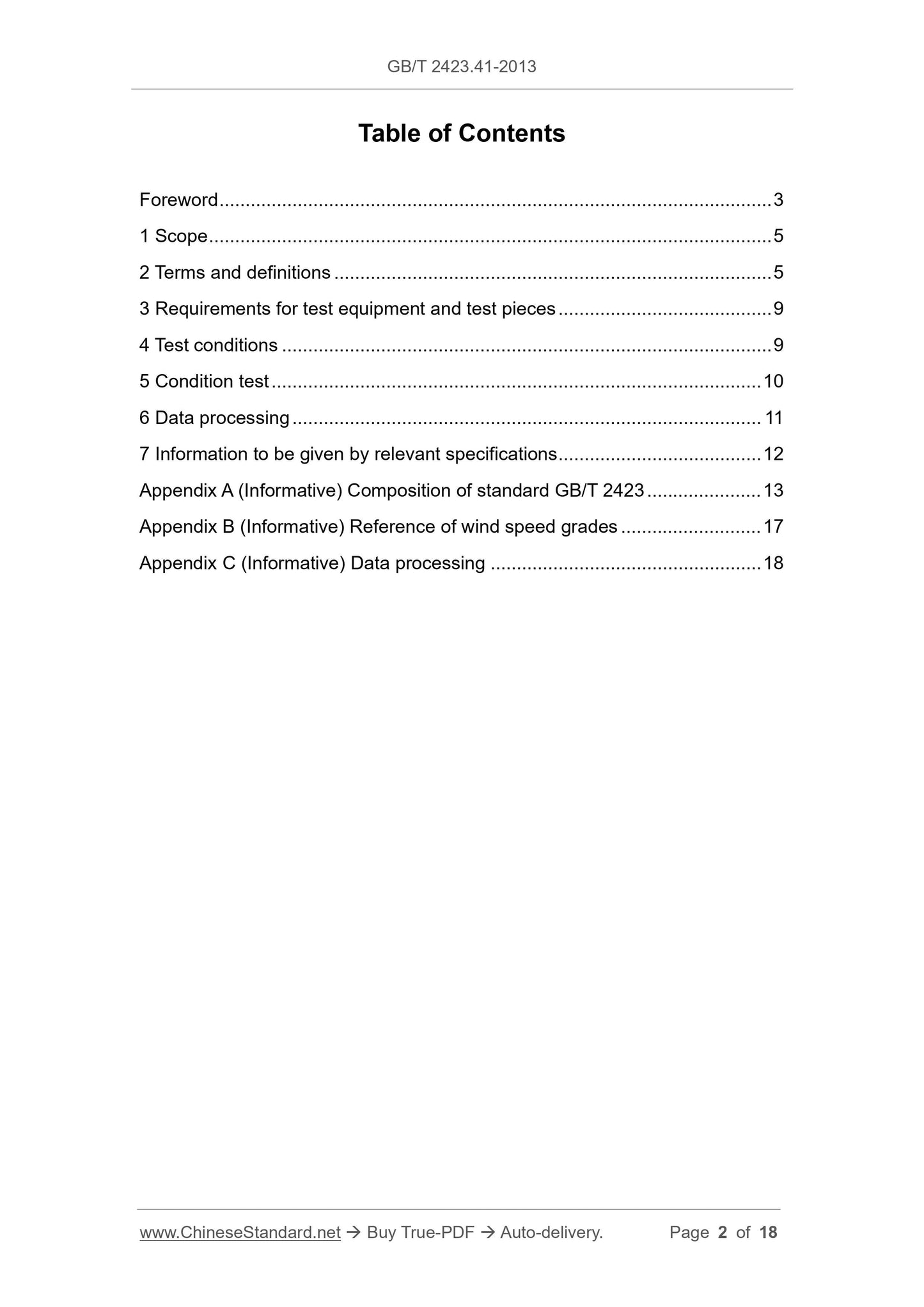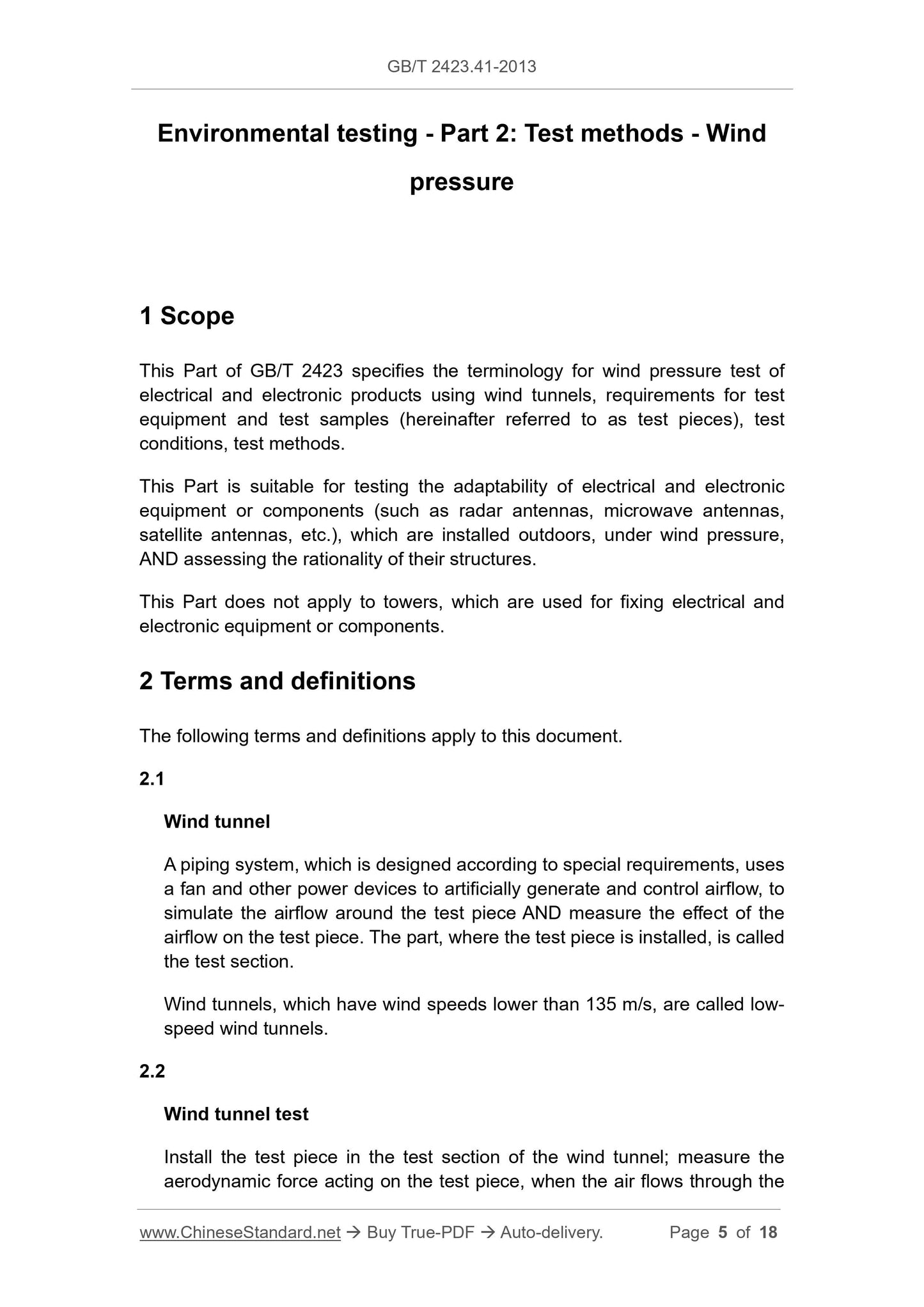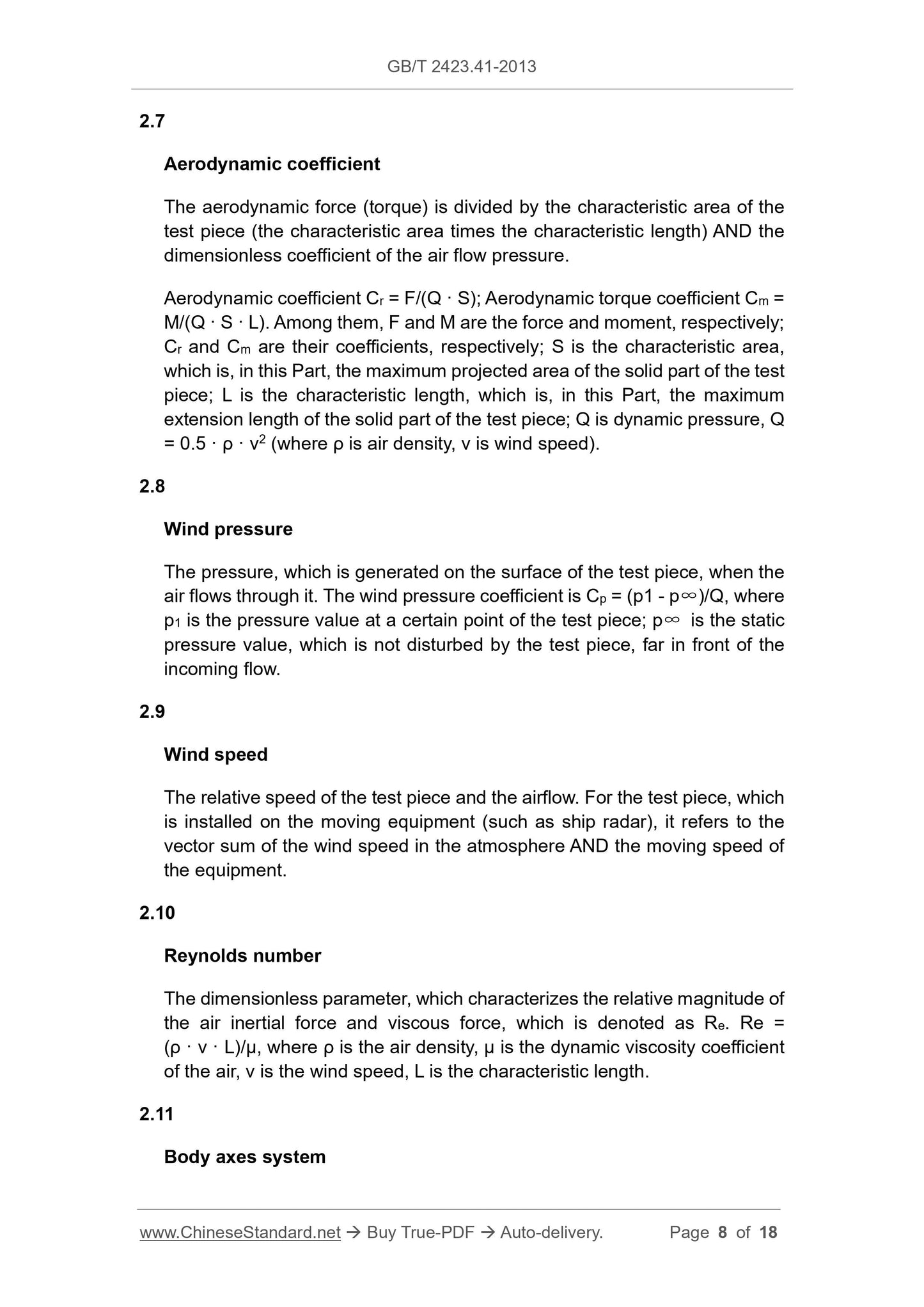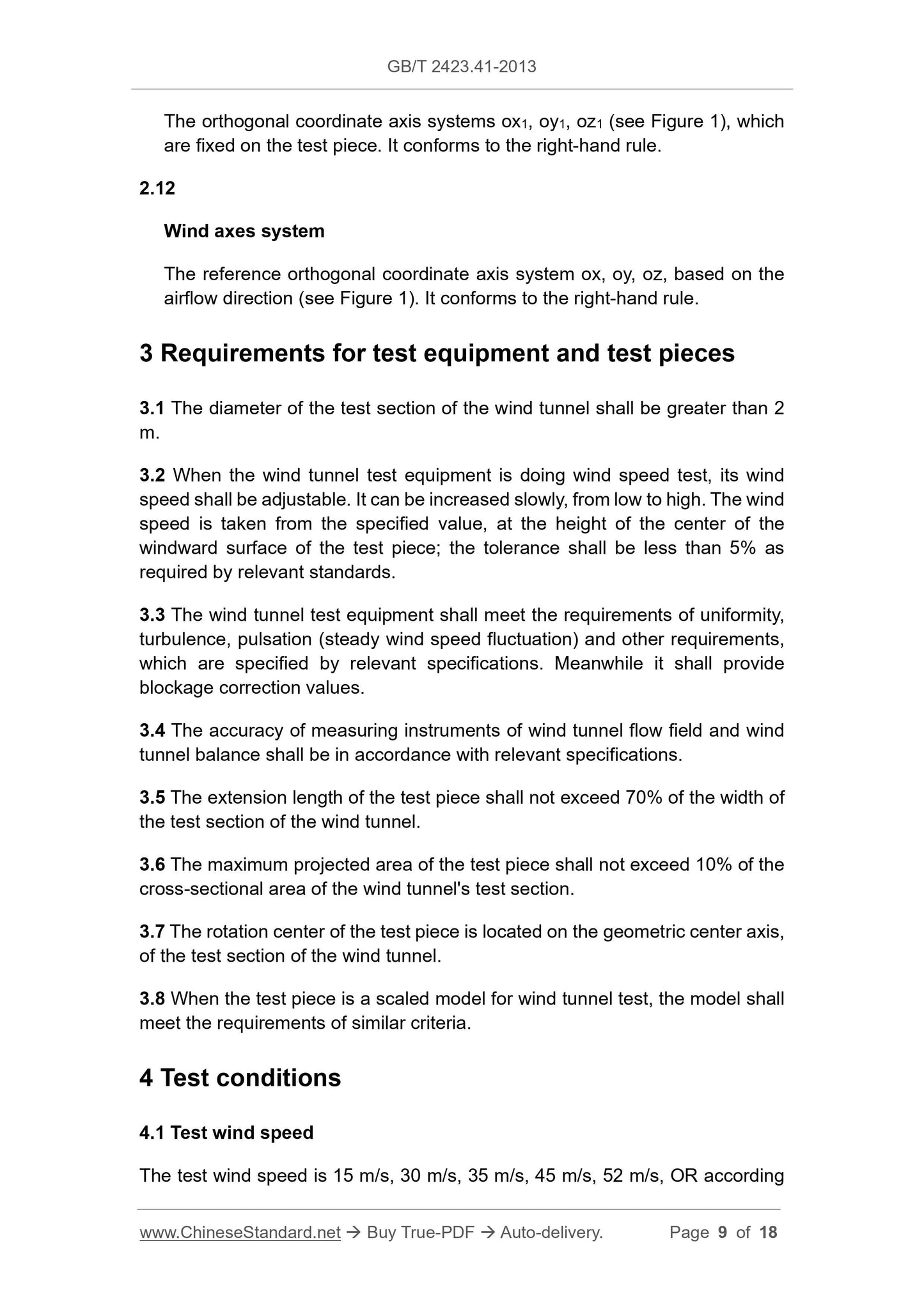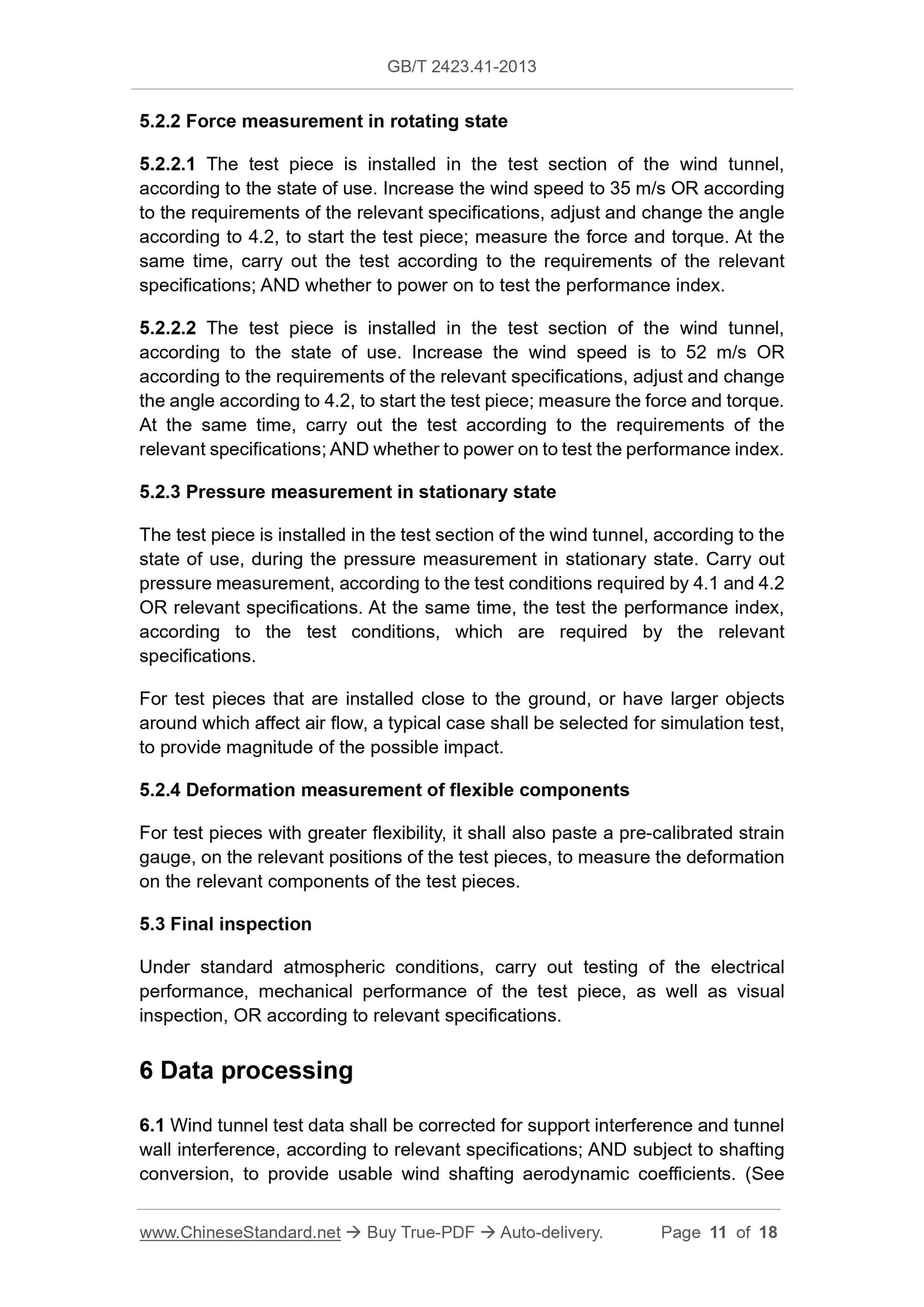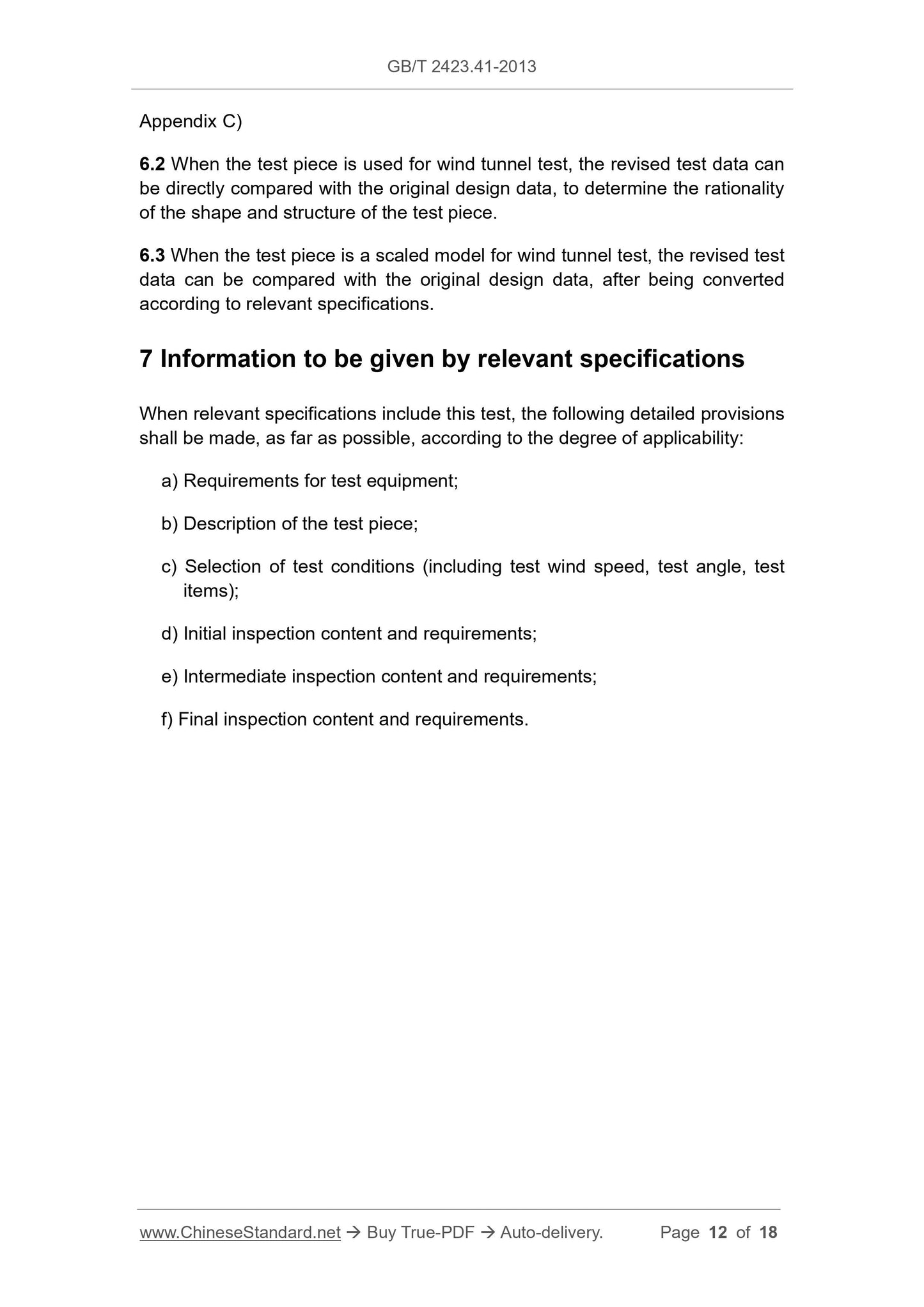1
/
of
7
PayPal, credit cards. Download editable-PDF & invoice In 1 second!
GB/T 2423.41-2013 English PDF (GBT2423.41-2013)
GB/T 2423.41-2013 English PDF (GBT2423.41-2013)
Regular price
$220.00 USD
Regular price
Sale price
$220.00 USD
Unit price
/
per
Shipping calculated at checkout.
Couldn't load pickup availability
Delivery: 3 seconds. Download true-PDF + Invoice.
Get QUOTATION in 1-minute: Click GB/T 2423.41-2013
Historical versions: GB/T 2423.41-2013
Preview True-PDF (Reload/Scroll if blank)
GB/T 2423.41-2013: Environmental testing - Part 2: Test methods - Wind pressure
GB/T 2423.41-2013
GB
NATIONAL STANDARD OF THE
PEOPLE’S REPUBLIC OF CHINA
ICS 19.040
K 04
Replacing GB/T 2423.41-1994
Environmental testing - Part 2: Test methods - Wind
pressure
ISSUED ON: NOVEMBER 12, 2013
IMPLEMENTED ON: MARCH 07, 2014
Issued by: General Administration of Quality Supervision, Inspection and
Quarantine of PRC;
Standardization Administration of PRC.
Table of Contents
Foreword ... 3
1 Scope ... 5
2 Terms and definitions ... 5
3 Requirements for test equipment and test pieces ... 9
4 Test conditions ... 9
5 Condition test ... 10
6 Data processing ... 11
7 Information to be given by relevant specifications ... 12
Appendix A (Informative) Composition of standard GB/T 2423 ... 13
Appendix B (Informative) Reference of wind speed grades ... 17
Appendix C (Informative) Data processing ... 18
Environmental testing - Part 2: Test methods - Wind
pressure
1 Scope
This Part of GB/T 2423 specifies the terminology for wind pressure test of
electrical and electronic products using wind tunnels, requirements for test
equipment and test samples (hereinafter referred to as test pieces), test
conditions, test methods.
This Part is suitable for testing the adaptability of electrical and electronic
equipment or components (such as radar antennas, microwave antennas,
satellite antennas, etc.), which are installed outdoors, under wind pressure,
AND assessing the rationality of their structures.
This Part does not apply to towers, which are used for fixing electrical and
electronic equipment or components.
2 Terms and definitions
The following terms and definitions apply to this document.
2.1
Wind tunnel
A piping system, which is designed according to special requirements, uses
a fan and other power devices to artificially generate and control airflow, to
simulate the airflow around the test piece AND measure the effect of the
airflow on the test piece. The part, where the test piece is installed, is called
the test section.
Wind tunnels, which have wind speeds lower than 135 m/s, are called low-
speed wind tunnels.
2.2
Wind tunnel test
Install the test piece in the test section of the wind tunnel; measure the
aerodynamic force acting on the test piece, when the air flows through the
2.7
Aerodynamic coefficient
The aerodynamic force (torque) is divided by the characteristic area of the
test piece (the characteristic area times the characteristic length) AND the
dimensionless coefficient of the air flow pressure.
Aerodynamic coefficient Cr = F/(Q · S); Aerodynamic torque coefficient Cm =
M/(Q · S · L). Among them, F and M are the force and moment, respectively;
Cr and Cm are their coefficients, respectively; S is the characteristic area,
which is, in this Part, the maximum projected area of the solid part of the test
piece; L is the characteristic length, which is, in this Part, the maximum
extension length of the solid part of the test piece; Q is dynamic pressure, Q
= 0.5 · ρ · v2 (where ρ is air density, v is wind speed).
2.8
Wind pressure
The pressure, which is generated on the surface of the test piece, when the
air flows through it. The wind pressure coefficient is Cp = (p1 - p∞)/Q, where
p1 is the pressure value at a certain point of the test piece; p∞ is the static
pressure value, which is not disturbed by the test piece, far in front of the
incoming flow.
2.9
Wind speed
The relative speed of the test piece and the airflow. For the test piece, which
is installed on the moving equipment (such as ship radar), it refers to the
vector sum of the wind speed in the atmosphere AND the moving speed of
the equipment.
2.10
Reynolds number
The dimensionless parameter, which characterizes the relative magnitude of
the air inertial force and viscous force, which is denoted as Re. Re =
(ρ · v · L)/μ, where ρ is the air density, μ is the dynamic viscosity coefficient
of the air, v is the wind speed, L is the characteristic length.
2.11
Body axes system
The orthogonal coordinate axis systems ox1, oy1, oz1 (see Figure 1), which
are fixed on the test piece. It conforms to the right-hand rule.
2.12
Wind axes system
The reference orthogonal coordinate axis system ox, oy, oz, based on the
airflow direction (see Figure 1). It conforms to the right-hand rule.
3 Requirements for test equipment and test pieces
3.1 The diameter of the test section of the wind tunnel shall be greater than 2
m.
3.2 When the wind tunnel test equipment is doing wind speed test, its wind
speed shall be adjustable. It can be increased slowly, from low to high. The wind
speed is taken from the specified value, at the height of the center of the
windward surface of the test piece; the tolerance shall be less than 5% as
required by relevant standards.
3.3 The wind tunnel test equipment shall meet the requirements of uniformity,
turbulence, pulsation (steady wind speed fluctuation) and other requirements,
which are specified by relevant specifications. Meanwhile it shall provide
blockage correction values.
3.4 The accuracy of measuring instruments of wind tunnel flow field and wind
tunnel balance shall be in accordance with relevant specifications.
3.5 The extension length of the test piece shall not exceed 70% of the width of
the test section of the wind tunnel.
3.6 The maximum projected area of the test piece shall not exceed 10% of the
cross-sectional area of the wind tunnel's test section.
3.7 The rotation center of the test piece is located on the geometric center axis,
of the test section of the wind tunnel.
3.8 When the test piece is a scaled model for wind tunnel test, the model shall
meet the requirements of similar criteria.
4 Test conditions
4.1 Test wind speed
The test wind speed is 15 m/s, 30 m/s, 35 m/s, 45 m/s, 52 m/s, OR according
5.2.2 Force measurement in rotating state
5.2.2.1 The test piece is installed in the test section of the wind tunnel,
according to the state of use. Increase the wind speed to 35 m/s OR according
to the requirements of the relevant specifications, adjust and change the angle
according to 4.2, to start the test piece; measure the force and torque. At the
same time, carry out the test according to the requirements of the relevant
specifications; AND whether to power on to test the performance index.
5.2.2.2 The test piece is installed in the test section of the wind tunnel,
according to the state of use. Increase the wind speed is to 52 m/s OR
according to the requirements of the relevant specifications, adjust and change
the angle according to 4.2, to start the test piece; measure the force and torque.
At the same time, carry out the test according to the requirements of the
relevant specifications; AND whether to power on to test the performance index.
5.2.3 Pressure measurement in stationary state
The test piece is installed in the test section of the wind tunnel, according to the
state of use, during the pressure measurement in stationary state. Carry out
pressure measurement, according to the test conditions required by 4.1 and 4.2
OR relevant specifications. At the same time, the test the performance index,
according to the test conditions, which are required by the relevant
specifications.
For test pieces that are installed close to the ground, or have larger objects
around which affect air flow, a typical case shall be selected for simulation test,
to prov...
Get QUOTATION in 1-minute: Click GB/T 2423.41-2013
Historical versions: GB/T 2423.41-2013
Preview True-PDF (Reload/Scroll if blank)
GB/T 2423.41-2013: Environmental testing - Part 2: Test methods - Wind pressure
GB/T 2423.41-2013
GB
NATIONAL STANDARD OF THE
PEOPLE’S REPUBLIC OF CHINA
ICS 19.040
K 04
Replacing GB/T 2423.41-1994
Environmental testing - Part 2: Test methods - Wind
pressure
ISSUED ON: NOVEMBER 12, 2013
IMPLEMENTED ON: MARCH 07, 2014
Issued by: General Administration of Quality Supervision, Inspection and
Quarantine of PRC;
Standardization Administration of PRC.
Table of Contents
Foreword ... 3
1 Scope ... 5
2 Terms and definitions ... 5
3 Requirements for test equipment and test pieces ... 9
4 Test conditions ... 9
5 Condition test ... 10
6 Data processing ... 11
7 Information to be given by relevant specifications ... 12
Appendix A (Informative) Composition of standard GB/T 2423 ... 13
Appendix B (Informative) Reference of wind speed grades ... 17
Appendix C (Informative) Data processing ... 18
Environmental testing - Part 2: Test methods - Wind
pressure
1 Scope
This Part of GB/T 2423 specifies the terminology for wind pressure test of
electrical and electronic products using wind tunnels, requirements for test
equipment and test samples (hereinafter referred to as test pieces), test
conditions, test methods.
This Part is suitable for testing the adaptability of electrical and electronic
equipment or components (such as radar antennas, microwave antennas,
satellite antennas, etc.), which are installed outdoors, under wind pressure,
AND assessing the rationality of their structures.
This Part does not apply to towers, which are used for fixing electrical and
electronic equipment or components.
2 Terms and definitions
The following terms and definitions apply to this document.
2.1
Wind tunnel
A piping system, which is designed according to special requirements, uses
a fan and other power devices to artificially generate and control airflow, to
simulate the airflow around the test piece AND measure the effect of the
airflow on the test piece. The part, where the test piece is installed, is called
the test section.
Wind tunnels, which have wind speeds lower than 135 m/s, are called low-
speed wind tunnels.
2.2
Wind tunnel test
Install the test piece in the test section of the wind tunnel; measure the
aerodynamic force acting on the test piece, when the air flows through the
2.7
Aerodynamic coefficient
The aerodynamic force (torque) is divided by the characteristic area of the
test piece (the characteristic area times the characteristic length) AND the
dimensionless coefficient of the air flow pressure.
Aerodynamic coefficient Cr = F/(Q · S); Aerodynamic torque coefficient Cm =
M/(Q · S · L). Among them, F and M are the force and moment, respectively;
Cr and Cm are their coefficients, respectively; S is the characteristic area,
which is, in this Part, the maximum projected area of the solid part of the test
piece; L is the characteristic length, which is, in this Part, the maximum
extension length of the solid part of the test piece; Q is dynamic pressure, Q
= 0.5 · ρ · v2 (where ρ is air density, v is wind speed).
2.8
Wind pressure
The pressure, which is generated on the surface of the test piece, when the
air flows through it. The wind pressure coefficient is Cp = (p1 - p∞)/Q, where
p1 is the pressure value at a certain point of the test piece; p∞ is the static
pressure value, which is not disturbed by the test piece, far in front of the
incoming flow.
2.9
Wind speed
The relative speed of the test piece and the airflow. For the test piece, which
is installed on the moving equipment (such as ship radar), it refers to the
vector sum of the wind speed in the atmosphere AND the moving speed of
the equipment.
2.10
Reynolds number
The dimensionless parameter, which characterizes the relative magnitude of
the air inertial force and viscous force, which is denoted as Re. Re =
(ρ · v · L)/μ, where ρ is the air density, μ is the dynamic viscosity coefficient
of the air, v is the wind speed, L is the characteristic length.
2.11
Body axes system
The orthogonal coordinate axis systems ox1, oy1, oz1 (see Figure 1), which
are fixed on the test piece. It conforms to the right-hand rule.
2.12
Wind axes system
The reference orthogonal coordinate axis system ox, oy, oz, based on the
airflow direction (see Figure 1). It conforms to the right-hand rule.
3 Requirements for test equipment and test pieces
3.1 The diameter of the test section of the wind tunnel shall be greater than 2
m.
3.2 When the wind tunnel test equipment is doing wind speed test, its wind
speed shall be adjustable. It can be increased slowly, from low to high. The wind
speed is taken from the specified value, at the height of the center of the
windward surface of the test piece; the tolerance shall be less than 5% as
required by relevant standards.
3.3 The wind tunnel test equipment shall meet the requirements of uniformity,
turbulence, pulsation (steady wind speed fluctuation) and other requirements,
which are specified by relevant specifications. Meanwhile it shall provide
blockage correction values.
3.4 The accuracy of measuring instruments of wind tunnel flow field and wind
tunnel balance shall be in accordance with relevant specifications.
3.5 The extension length of the test piece shall not exceed 70% of the width of
the test section of the wind tunnel.
3.6 The maximum projected area of the test piece shall not exceed 10% of the
cross-sectional area of the wind tunnel's test section.
3.7 The rotation center of the test piece is located on the geometric center axis,
of the test section of the wind tunnel.
3.8 When the test piece is a scaled model for wind tunnel test, the model shall
meet the requirements of similar criteria.
4 Test conditions
4.1 Test wind speed
The test wind speed is 15 m/s, 30 m/s, 35 m/s, 45 m/s, 52 m/s, OR according
5.2.2 Force measurement in rotating state
5.2.2.1 The test piece is installed in the test section of the wind tunnel,
according to the state of use. Increase the wind speed to 35 m/s OR according
to the requirements of the relevant specifications, adjust and change the angle
according to 4.2, to start the test piece; measure the force and torque. At the
same time, carry out the test according to the requirements of the relevant
specifications; AND whether to power on to test the performance index.
5.2.2.2 The test piece is installed in the test section of the wind tunnel,
according to the state of use. Increase the wind speed is to 52 m/s OR
according to the requirements of the relevant specifications, adjust and change
the angle according to 4.2, to start the test piece; measure the force and torque.
At the same time, carry out the test according to the requirements of the
relevant specifications; AND whether to power on to test the performance index.
5.2.3 Pressure measurement in stationary state
The test piece is installed in the test section of the wind tunnel, according to the
state of use, during the pressure measurement in stationary state. Carry out
pressure measurement, according to the test conditions required by 4.1 and 4.2
OR relevant specifications. At the same time, the test the performance index,
according to the test conditions, which are required by the relevant
specifications.
For test pieces that are installed close to the ground, or have larger objects
around which affect air flow, a typical case shall be selected for simulation test,
to prov...
Share
